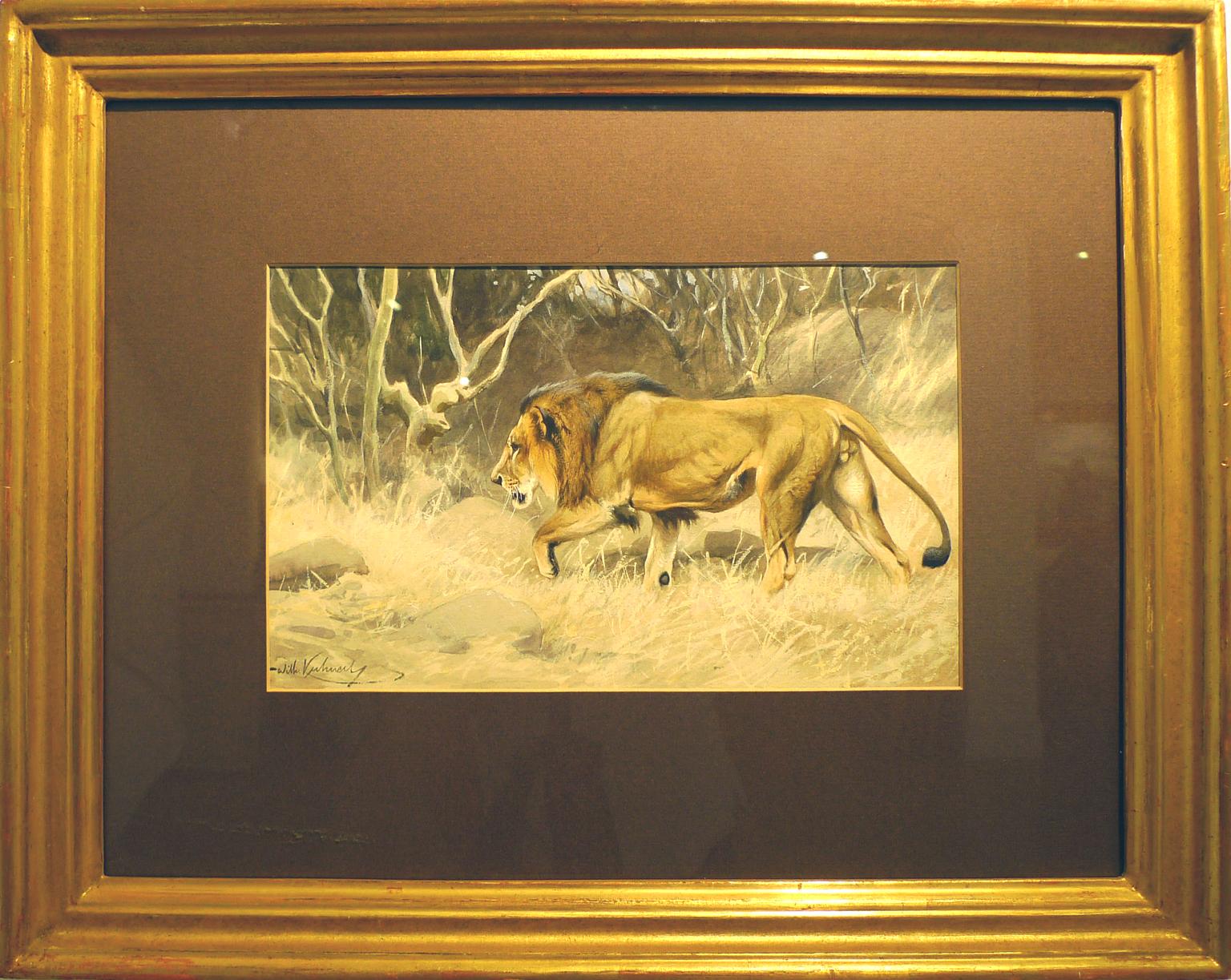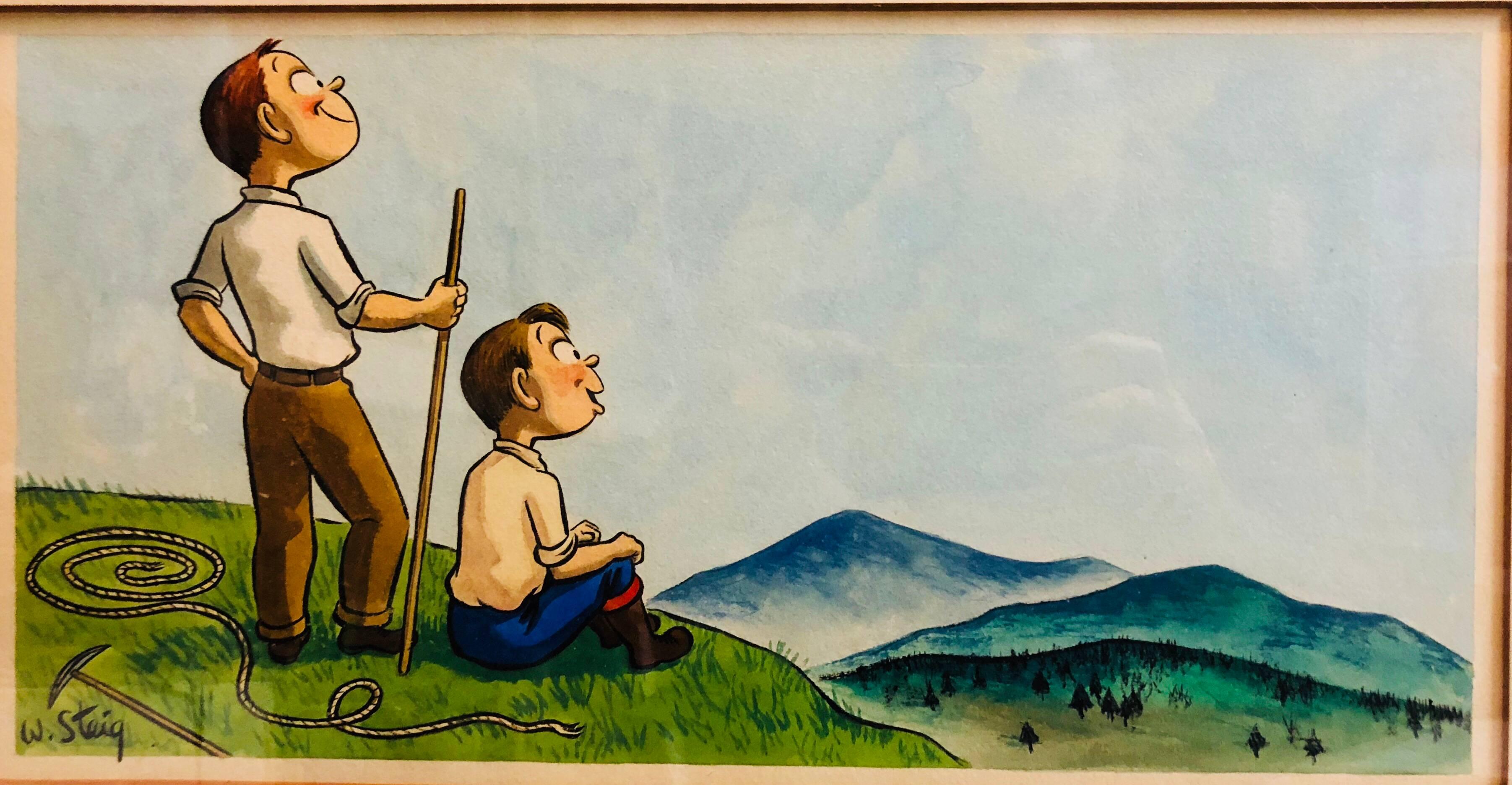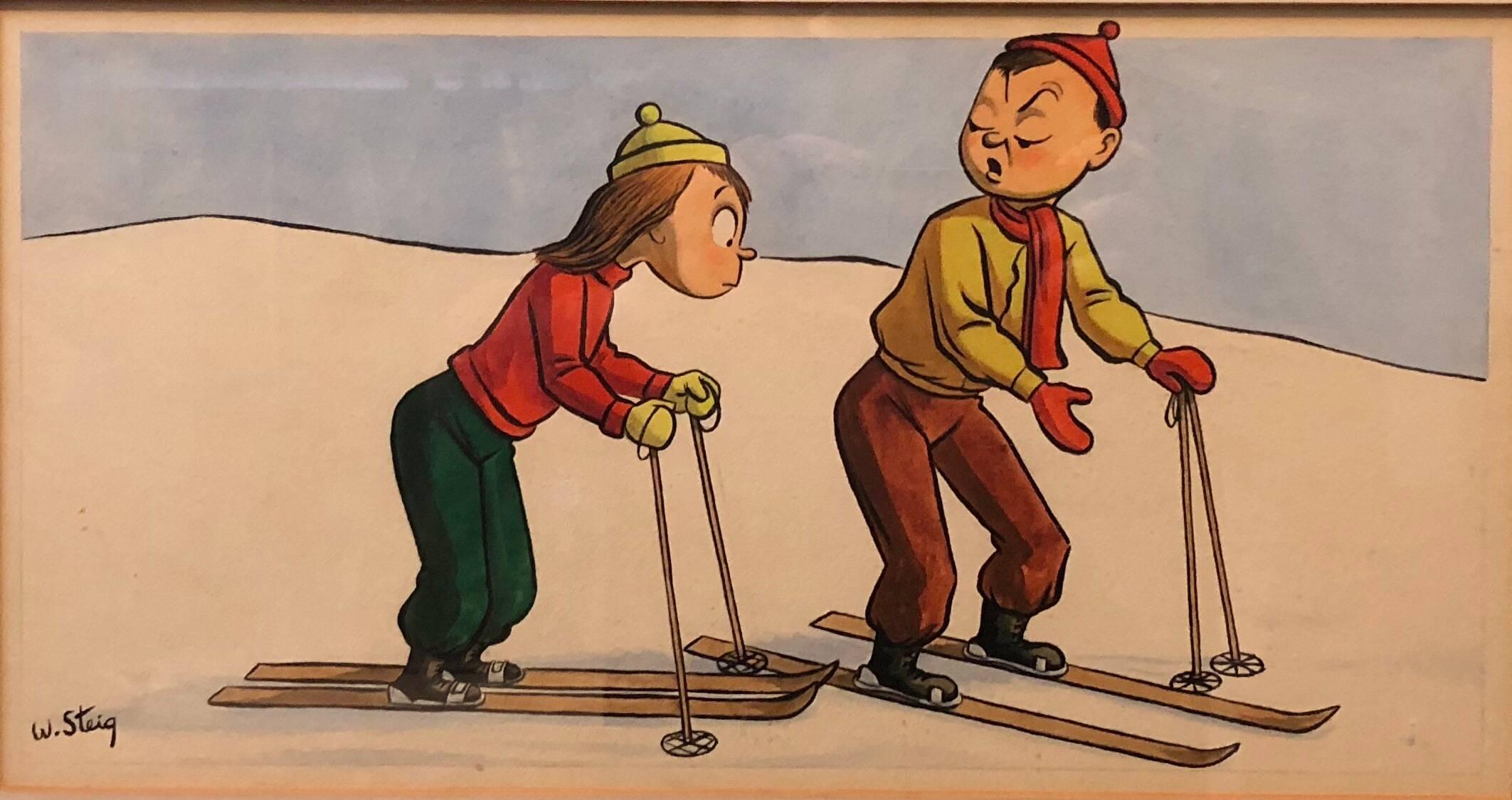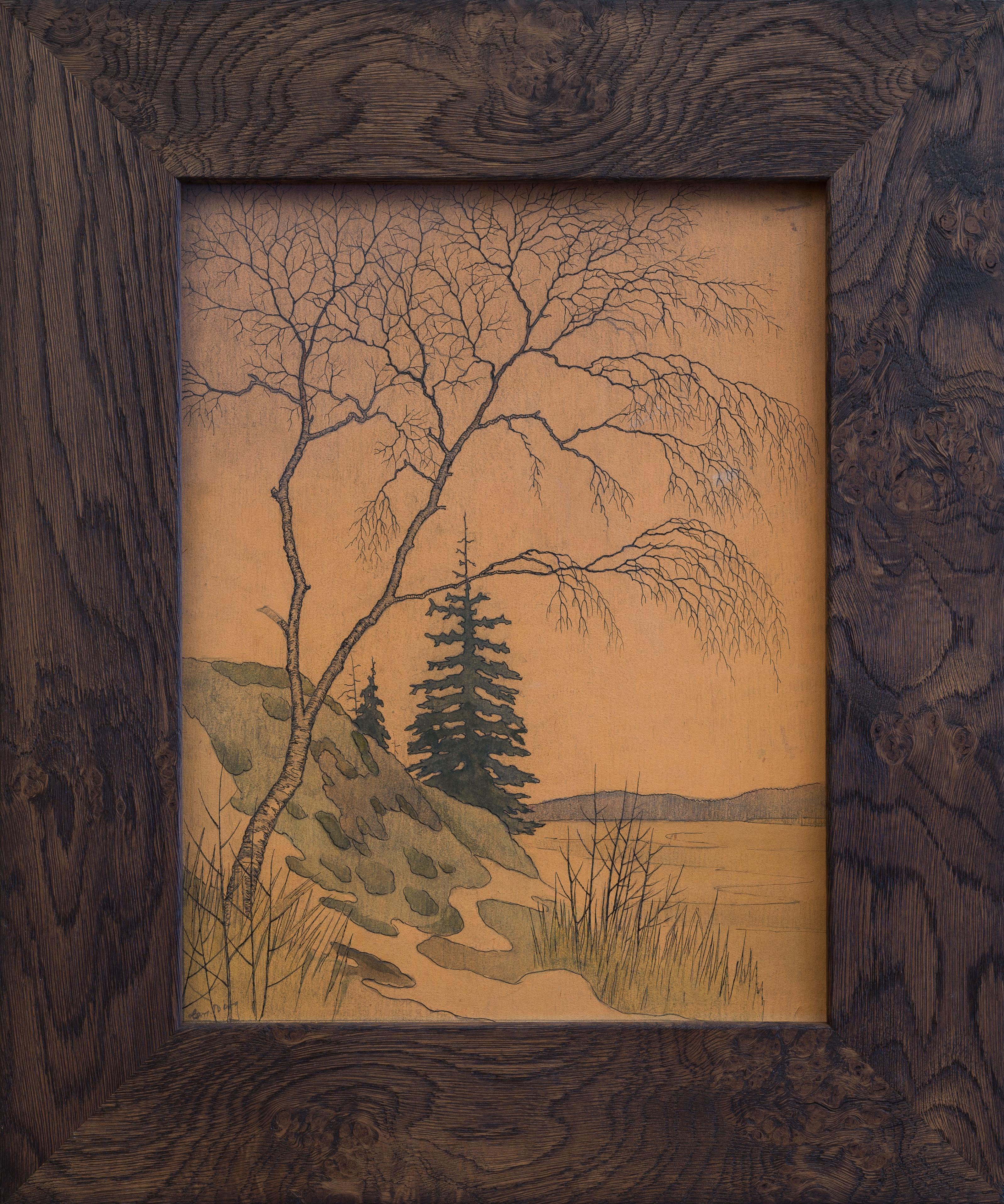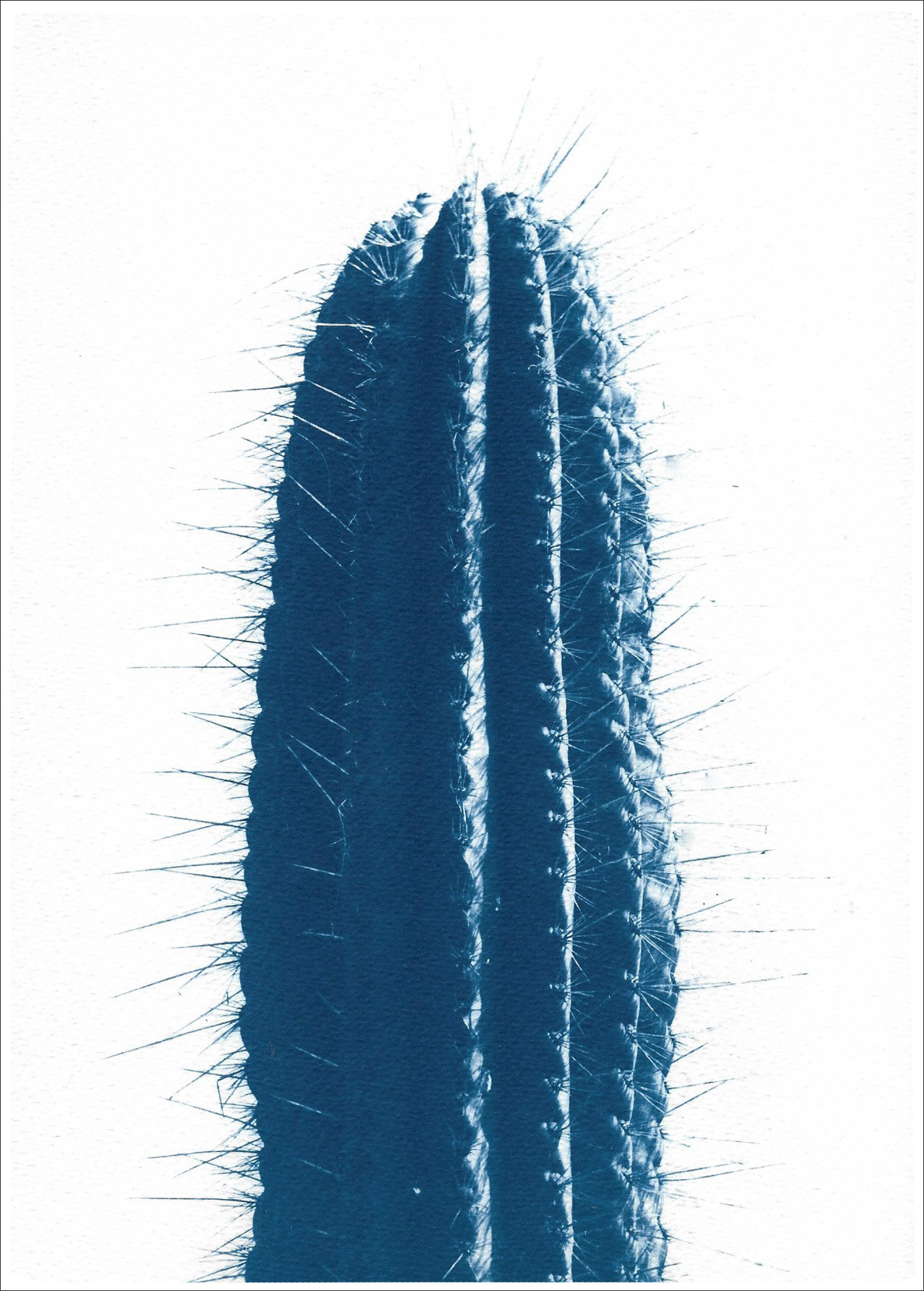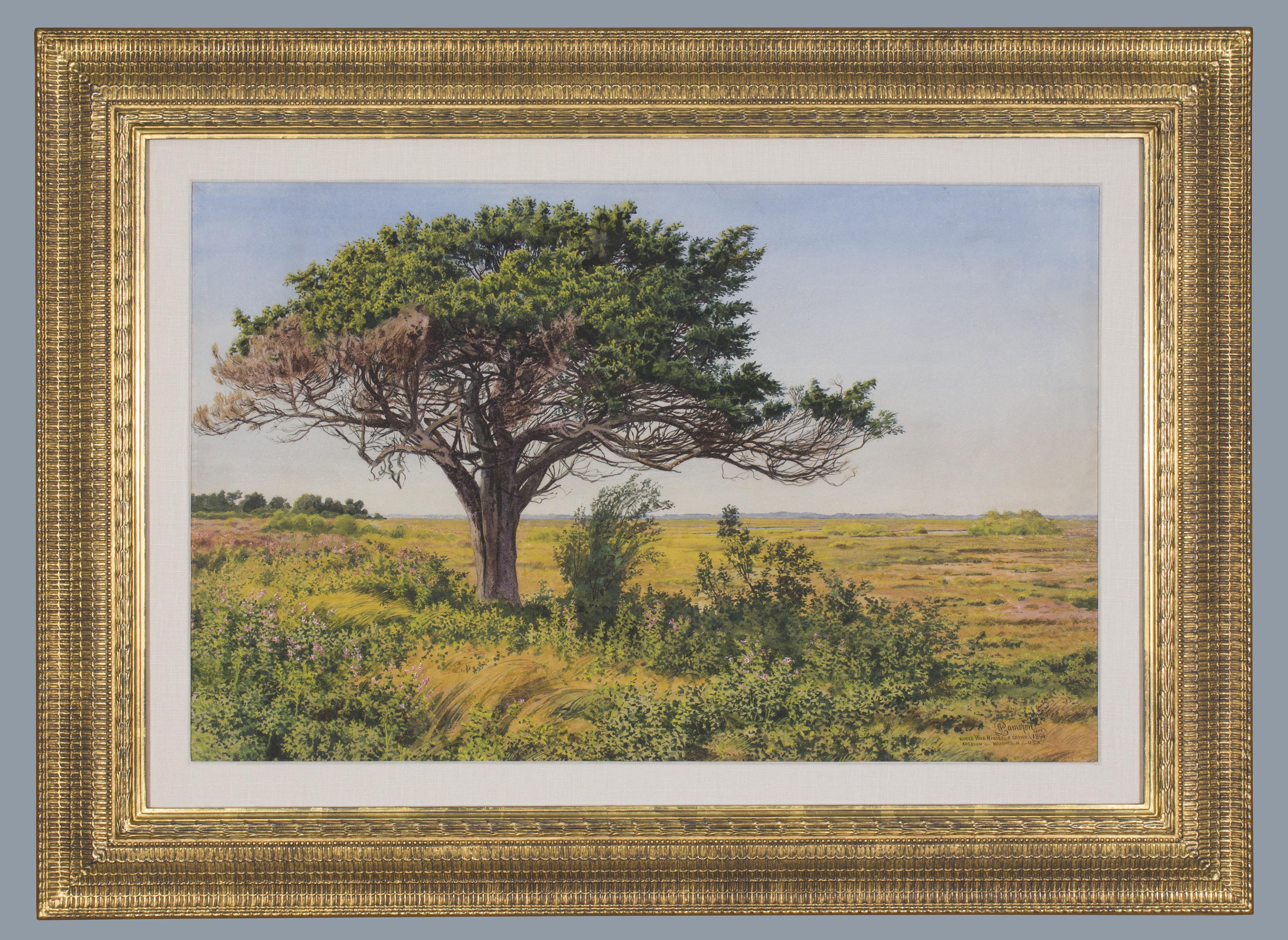Items Similar to Sunrise Over Mt. Fuji, Japanese Watercolor Landscape
Want more images or videos?
Request additional images or videos from the seller
Emiko SatsutaSunrise Over Mt. Fuji, Japanese Watercolor Landscapeearly-mid 20th Century
early-mid 20th Century
About the Item
Idyllic depiction of Mount Fuji by Japanese artist Emiko Satsuta (early 20th Century). Muted colors create a serene atmosphere, with Mount Fuji in the background, towering over the river and village. Reflections in the still water are expertly executed, adding a sense of depth to the foreground. Traditional Japanese Minka huts indicate that the inhabitants of the village were farmers, artisans, or merchants. Signed in the lower right corner. Presented in an ornate wood frame.
Image size: 11.75"H x 25.5"W. Emiko Satsuta was a excellent watercolor and woodcut artist in pre and postwar Japan. Little is known of this period artists that sold to re-construction tourists and visitors post-war.
- Creator:Emiko Satsuta (Japanese)
- Creation Year:early-mid 20th Century
- Dimensions:Height: 15.75 in (40.01 cm)Width: 38.5 in (97.79 cm)Depth: 0.75 in (1.91 cm)
- Medium:
- Movement & Style:
- Period:
- Condition:Some tonal ageing to cardstock. Minor scratches on frame.
- Gallery Location:Soquel, CA
- Reference Number:
About the Seller
4.9
Platinum Seller
These expertly vetted sellers are 1stDibs' most experienced sellers and are rated highest by our customers.
Established in 1986
1stDibs seller since 2014
2,528 sales on 1stDibs
Typical response time: <1 hour
- ShippingRetrieving quote...Ships From: Soquel, CA
- Return PolicyA return for this item may be initiated within 14 days of delivery.
More From This SellerView All
- Mountains and Valley AutumnalLocated in Soquel, CASerene cloudy landscape by Arthur Philemon Coleman (Canada, 1852-1939). From atop a hill, the viewer looks across a valley. There are a few outcroppings of trees, as well as a farmhouse and livestock. In the far distance, rolling hills with exposed rock are seen in the distance. Signed "A. Coleman" in the lower left corner. Presented in a double mat with foam core backing. Image size: 9.75"H x 16"W Mat size: 14.88"H x 21.75"W Some age toning to paper and an age toned section is in the center of the painting running from top to bottom. Arthur Coleman...Category
Late 19th Century Naturalistic Landscape Drawings and Watercolors
MaterialsPaper, Watercolor
- Mid Century California Mission LandscapeLocated in Soquel, CABeautiful mid century landscape of a historic California mission, highlighting its iconic architectural details such as a columned arches, white was...Category
Mid-20th Century American Impressionist Landscape Paintings
MaterialsGouache, Cardboard, Paper
- Country Lane in the Pine Forest - Mid Century Landscape WatercolorBy Joseph YeagerLocated in Soquel, CAWonderful mid century country lane in the pines landscape watercolor by Joseph Yeager (American, 20th Century). This piece is unsigned, but was acquired with a collection of Yeager w...Category
Mid-20th Century American Impressionist Landscape Drawings and Watercolors
MaterialsWatercolor, Cardboard, Paper
- Cowboy in the Canyon, Small Contemporary Multicolor Abstract Figural LandscapeBy Tiffanie MangLocated in Soquel, CASmall-scale yet bold multi-colored abstracted figurative landscape of a horse rider in a canyon (a study after Edgar Payne’s works) by Tiffanie Mang (Ameri...Category
2010s American Impressionist Figurative Drawings and Watercolors
MaterialsCardboard, Gouache
- Loading the Cargo Ship - Brittany France - Watercolor 19th CenturyLocated in Soquel, CAFrench Coastal Scene in Brittany with a merchant ship onloading fish and people by an unknown artist. A sailing vessel is anchored at a beach. A ramp extends from the ship yo to the ...Category
Late 19th Century Impressionist Figurative Drawings and Watercolors
MaterialsPostcard, Illustration Board, Watercolor
- The Nailsmith Houses, Late 19th Century Rattenberg Austria Historical LandscapeLocated in Soquel, CAThe Nailsmith Houses, Late 19th Century Rattenberg Austria Historical Landscape Exquisitely detailed 1888 watercolor of The Nailsmith Houses, a historical building in Rattenberg, A...Category
1880s Realist Landscape Drawings and Watercolors
MaterialsWatercolor, Illustration Board, Paper
You May Also Like
- "Lion on the move", 19th Century watercolour by German painter Wilhelm KuhnertBy Wilhelm KuhnertLocated in Madrid, ESWILHELM KUHNERT German, 1865 - 1926 LION ON THE MOVE signed "Wilh. Kuhnert" (lower left) Watercolour on cardboard 6-1/2 X 10-1/2 inches (16.5 X 26.5 cm.) framed: 14-1/4 X 17-3/4 inches (35.8X 44.8 cm.) PROVENANCE Private Collection, Munich, Germany Private Spanish Collection, Madrid Friedrich Wilhelm Kuhnert (September 18, 1865 – February 11...Category
1920s Naturalistic Animal Drawings and Watercolors
MaterialsWatercolor, Cardboard
- Whimsical Illustration Hiking Cartoon, 1938 Mt Tremblant Ski Lodge William SteigBy William Steig (b.1907)Located in Surfside, FLLighthearted Illustration of Outdoor Pursuits This one being cross country hiking signed "W. Steig" Provenance: from Mrs. Joseph B. Ryan, Commissioned by Joe Ryan for the bar at his ski resort, Mount Tremblant Lodge, in 1938. Mont Tremblant, P.Q., Canada Watercolor and ink on illustration board, sights sizes 8 1/2 x 16 1/2 in., framed. In 1938 Joe Ryan, described as a millionaire from Philadelphia, bushwhacked his way to the summit of Mont Tremblant and was inspired to create a world class ski resort at the site. In 1939 he opened the Mont Tremblant Lodge, which remains part of the Pedestrian Village today. This original illustration is on Whatman Illustration board. the board measures 14 X 22 inches. label from McClees Galleries, Philadelphia, on the frame backing paper. William Steig, 1907 – 2003 was an American cartoonist, sculptor, and, in his later life, an illustrator and writer of children's books. Best known for the picture books Sylvester and the Magic Pebble, Abel's Island, and Doctor De Soto, he was also the creator of Shrek!, which inspired the film series of the same name. He was the U.S. nominee for both of the biennial, international Hans Christian Andersen Awards, as a children's book illustrator in 1982 and a writer in 1988. Steig was born in Brooklyn, New York in 1907, and grew up in the Bronx. His parents were Polish-Jewish immigrants from Austria, both socialists. His father, Joseph Steig, was a house painter, and his mother, Laura Ebel Steig, was a seamstress who encouraged his artistic leanings. As a child, he dabbled in painting and was an avid reader of literature. Among other works, he was said to have been especially fascinated by Pinocchio.He graduated from Townsend Harris High School at 15 but never completed college, though he attended three, spending two years at City College of New York, three years at the National Academy of Design and a mere five days at the Yale School of Fine Arts before dropping out of each. Hailed as the "King of Cartoons" Steig began drawing illustrations and cartoons for The New Yorker in 1930, producing more than 2,600 drawings and 117 covers for the magazine. Steig, later, when he was 61, began writing children's books. In 1968, he wrote his first children's book. He excelled here as well, and his third book, Sylvester and the Magic Pebble (1969), won the Caldecott Medal. He went on to write more than 30 children's books, including the Doctor DeSoto series, and he continued to write into his nineties. Among his other well-known works, the picture book Shrek! (1990) formed the basis for the DreamWorks Animation film Shrek (2001). After the release of Shrek 2 in 2004, Steig became the first sole-creator of an animated movie franchise that went on to generate over $1 billion from theatrical and ancillary markets after only one sequel. Along with Maurice Sendak, Saul Steinberg, Ludwig Bemelmans and Laurent de Brunhofff his is one of those rare cartoonist whose works form part of our collective cultural heritage. In 1984, Steig's film adaptation of Doctor DeSoto directed by Michael Sporn was nominated for the Academy Award for Best Animated Short Film. As one of the most admired cartoonists of all time, Steig spent seven decades drawing for the New Yorker magazine. He touched generations of readers with his tongue–in–cheek pen–and–ink drawings, which often expressed states of mind like shame, embarrassment or anger. Later in life, Steig turned to children's books, working as both a writer and illustrator. Steig's children's books were also wildly popular because of the crazy, complicated language he used—words like lunatic, palsied, sequestration, and cleave. Kids love the sound of those words even if they do not quite understand the meaning. Steig's descriptions were also clever. He once described a beached whale as "breaded with sand." Throughout the course of his career, Steig compiled his cartoons and drawings into books. Some of them were published first in the New Yorker. Others were deemed too dark to be printed there. Most of these collections centered on the cold, dark psychoanalytical truth about relationships. They featured husbands and wives fighting and parents snapping at their kids. His first adult book, Man About Town, was published in 1932, followed by About People, published in 1939, which focused on social outsiders. Sick of Each Other, published in 2000, included a drawing depicting a wife holding her husband at gunpoint, saying, "Say you adore me." According to the Los Angeles Times, fellow New Yorker artist Edward Sorel...Category
1930s Naturalistic Figurative Drawings and Watercolors
MaterialsArchival Ink, Watercolor, Illustration Board
- Whimsical Illustration Skiing Cartoon, 1938 Mt Tremblant Ski Lodge William SteigBy William Steig (b.1907)Located in Surfside, FLLighthearted Illustration of Outdoor Pursuits This one being a Skiing scene, a boy and a girl on skis. signed W. Steig Provenance: from Mrs. Joseph B. Ryan, Commissioned by Joe Ryan for the bar at his ski resort, Mount Tremblant Lodge, in 1938. Mont Tremblant, P.Q., Canada Watercolor and ink on illustration board, sights sizes 8 1/2 x 16 1/2 in., framed. In 1938 Joe Ryan, described as a millionaire from Philadelphia, bushwhacked his way to the summit of Mont Tremblant and was inspired to create a world class ski resort at the site. In 1939 he opened the Mont Tremblant Lodge, which remains part of the Pedestrian Village today. This original illustration is on Whatman Illustration board. the board measures 14 X 22 inches. label from McClees Galleries, Philadelphia, on the frame backing paper. William Steig, 1907 – 2003 was an American cartoonist, sculptor, and, in his later life, an illustrator and writer of children's books. Best known for the picture books Sylvester and the Magic Pebble, Abel's Island, and Doctor De Soto, he was also the creator of Shrek!, which inspired the film series of the same name. He was the U.S. nominee for both of the biennial, international Hans Christian Andersen Awards, as a children's book illustrator in 1982 and a writer in 1988. Steig was born in Brooklyn, New York in 1907, and grew up in the Bronx. His parents were Polish-Jewish immigrants from Austria, both socialists. His father, Joseph Steig, was a house painter, and his mother, Laura Ebel Steig, was a seamstress who encouraged his artistic leanings. As a child, he dabbled in painting and was an avid reader of literature. Among other works, he was said to have been especially fascinated by Pinocchio.He graduated from Townsend Harris High School at 15 but never completed college, though he attended three, spending two years at City College of New York, three years at the National Academy of Design and a mere five days at the Yale School of Fine Arts before dropping out of each. Hailed as the "King of Cartoons" Steig began drawing illustrations and cartoons for The New Yorker in 1930, producing more than 2,600 drawings and 117 covers for the magazine. Steig, later, when he was 61, began writing children's books. In 1968, he wrote his first children's book. He excelled here as well, and his third book, Sylvester and the Magic Pebble (1969), won the Caldecott Medal. He went on to write more than 30 children's books, including the Doctor DeSoto series, and he continued to write into his nineties. Among his other well-known works, the picture book Shrek! (1990) formed the basis for the DreamWorks Animation film Shrek (2001). After the release of Shrek 2 in 2004, Steig became the first sole-creator of an animated movie franchise that went on to generate over $1 billion from theatrical and ancillary markets after only one sequel. Along with Maurice Sendak, Saul Steinberg, Ludwig Bemelmans and Laurent de Brunhofff his is one of those rare cartoonist whose works form part of our collective cultural heritage. In 1984, Steig's film adaptation of Doctor DeSoto directed by Michael Sporn was nominated for the Academy Award for Best Animated Short Film. As one of the most admired cartoonists of all time, Steig spent seven decades drawing for the New Yorker magazine. He touched generations of readers with his tongue–in–cheek pen–and–ink drawings, which often expressed states of mind like shame, embarrassment or anger. Later in life, Steig turned to children's books, working as both a writer and illustrator. Steig's children's books were also wildly popular because of the crazy, complicated language he used—words like lunatic, palsied, sequestration, and cleave. Kids love the sound of those words even if they do not quite understand the meaning. Steig's descriptions were also clever. He once described a beached whale as "breaded with sand." Throughout the course of his career, Steig compiled his cartoons and drawings into books. Some of them were published first in the New Yorker. Others were deemed too dark to be printed there. Most of these collections centered on the cold, dark psychoanalytical truth about relationships. They featured husbands and wives fighting and parents snapping at their kids. His first adult book, Man About Town, was published in 1932, followed by About People, published in 1939, which focused on social outsiders. Sick of Each Other, published in 2000, included a drawing depicting a wife holding her husband at gunpoint, saying, "Say you adore me." According to the Los Angeles Times, fellow New Yorker artist Edward Sorel...Category
1930s Naturalistic Figurative Drawings and Watercolors
MaterialsArchival Ink, Watercolor, Illustration Board
- Beneath the Birch Drawing by Swedish Artist Christian Berg (1893–1976)Located in Stockholm, SEWe are proud to present an exquisite drawing by the renowned artist Christian Berg (1893-1976), executed around the 1920s. This captivating artwork port...Category
1920s Naturalistic Landscape Drawings and Watercolors
MaterialsWatercolor, Board, Pencil
- Blue Upright Desert Cactus, Extra Large Cyanotype Print in Blue Tones, BotanicBy Kind of CyanLocated in Barcelona, ESThis is an exclusive handprinted limited edition cyanotype of a beautiful "Blue Upright Desert Cactus". Details: + Title: Blue Upright Desert Cactus + Year: 2022 + Edition Size: 100...Category
2010s Naturalistic Landscape Prints
MaterialsPhotogram, Other Medium, Photographic Film, Emulsion, Watercolor, Archiv...
- Where Wild Hibiscus Grows, Absecon Island, NJ, Watercolor of Jersey Shore 1894Located in Philadelphia, PAPeter Caledon Cameron (American, born Scotland, 1852-c. 1920) Absecon Island, New Jersey, 1894 Watercolor on paper, 17 1/2 x 27 inches (sight) FRAMED: 26 1/2 x 36 1/2 inches Signed and dated at lower left: "ABSECON.ISLAND./ N.J-U.S.A Cameron/1894" N.J-U.S.A Cameron/1894" Born in Perth, Scotland, Peter Caledon Cameron won awards for drawing and penmanship at a Glasgow public school. He claimed that at the age of fourteen his watercolors were already "in demand," and that before turning twenty he had "crossed every ocean in the world, sketching and painting as he went." He attended the Government School of Design in London and was certified as an art master in 1883. Cameron immigrated to the United States that year, settled in Philadelphia, and commenced work on large history paintings such as Niagara in Winter (unlocated) and Vesuvius in Grand Eruption (unlocated) that he exhibited in various northern cities. He exhibited one painting at the Pennsylvania Academy of the Fine Arts in 1902. Nothing is known of his activities later in life. In a lengthy inscription that accompanies this watercolor, Cameron noted that Absecon was "a piece of the best sand-dune region characteristic of the whole coast of New Jersey State from Sandy Hook point in the North to Cape May Point in the extreme south." This was one among a number of studies the artist made for a large oil painting titled "Captain Kidd Burying His Treasure" (unlocated). The famous Scottish privateer Captain William Kidd...Category
1890s Naturalistic Landscape Drawings and Watercolors
MaterialsPaper, Watercolor
Recently Viewed
View AllMore Ways To Browse
Vintage Over
War Is Over
Japan Landscape
Japanese Landscape Artist
Japan Drawing
Over The River
Ornate Wood
Mount Fuji
Japanese Landscape Framed Art
Japanese Village
Ornate Wood Frames
Fuji Vintage
Japanese Vintage Background
Mid Century Water Colors
Japanese Woodcut Landscape
Sunrise Vintage
Vintage Huts
Vintage Hut
